Managing Communication, Knowledge, and Information for ASUS - Report
VerifiedAdded on 2020/06/05
|19
|6090
|46
Report
AI Summary
This report examines the management of communication, knowledge, and information for ASUS, focusing on its marketing strategies and the role of its merchandising organization, J. Walter Thompson (JWT). The report analyzes the extent of decision-making, the information and knowledge required for effective decisions, and the internal and external data sources available to employees. It identifies stakeholders, explores methods for developing stakeholder relationships, and assesses their impact on the business. Furthermore, the report details the communication process, suggests ways to improve it, and proposes a personal development plan for communication. Finally, it reports on existing approaches, suggests improvements, and outlines an implementation strategy for enhanced communication and knowledge management within ASUS and its marketing efforts.
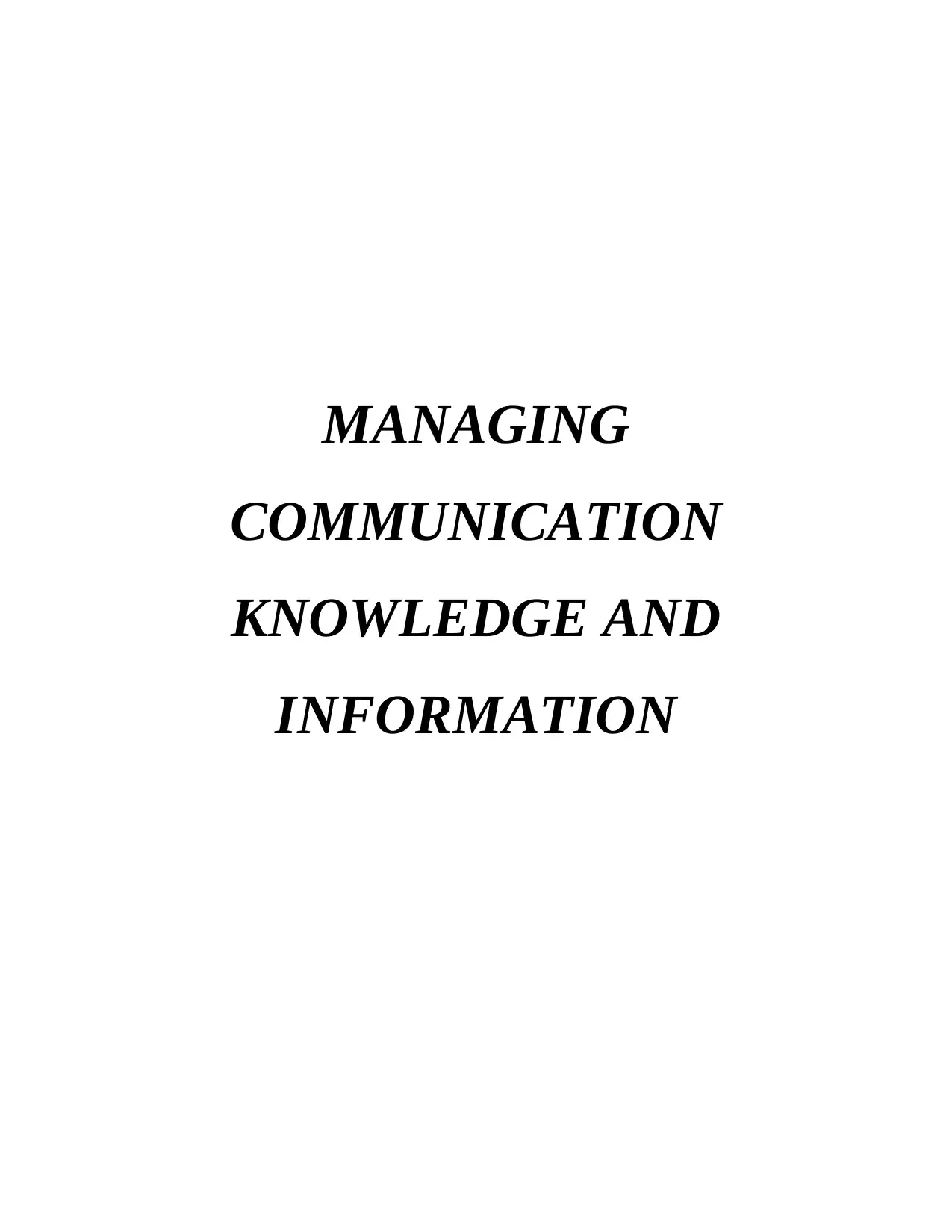
MANAGING
COMMUNICATION
KNOWLEDGE AND
INFORMATION
COMMUNICATION
KNOWLEDGE AND
INFORMATION
Paraphrase This Document
Need a fresh take? Get an instant paraphrase of this document with our AI Paraphraser
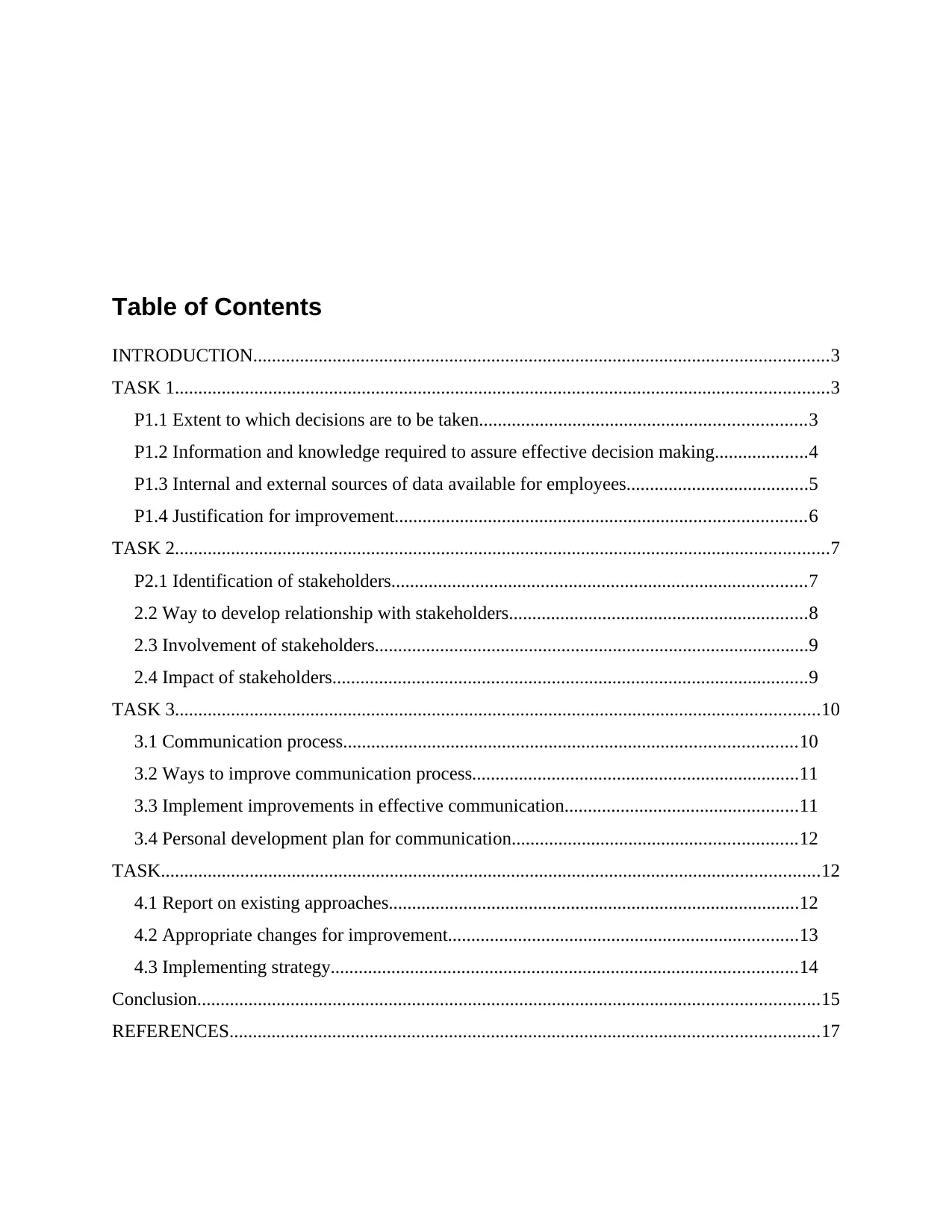
Table of Contents
INTRODUCTION...........................................................................................................................3
TASK 1............................................................................................................................................3
P1.1 Extent to which decisions are to be taken......................................................................3
P1.2 Information and knowledge required to assure effective decision making....................4
P1.3 Internal and external sources of data available for employees.......................................5
P1.4 Justification for improvement........................................................................................6
TASK 2............................................................................................................................................7
P2.1 Identification of stakeholders.........................................................................................7
2.2 Way to develop relationship with stakeholders................................................................8
2.3 Involvement of stakeholders.............................................................................................9
2.4 Impact of stakeholders......................................................................................................9
TASK 3..........................................................................................................................................10
3.1 Communication process.................................................................................................10
3.2 Ways to improve communication process......................................................................11
3.3 Implement improvements in effective communication..................................................11
3.4 Personal development plan for communication.............................................................12
TASK.............................................................................................................................................12
4.1 Report on existing approaches........................................................................................12
4.2 Appropriate changes for improvement...........................................................................13
4.3 Implementing strategy....................................................................................................14
Conclusion.....................................................................................................................................15
REFERENCES..............................................................................................................................17
INTRODUCTION...........................................................................................................................3
TASK 1............................................................................................................................................3
P1.1 Extent to which decisions are to be taken......................................................................3
P1.2 Information and knowledge required to assure effective decision making....................4
P1.3 Internal and external sources of data available for employees.......................................5
P1.4 Justification for improvement........................................................................................6
TASK 2............................................................................................................................................7
P2.1 Identification of stakeholders.........................................................................................7
2.2 Way to develop relationship with stakeholders................................................................8
2.3 Involvement of stakeholders.............................................................................................9
2.4 Impact of stakeholders......................................................................................................9
TASK 3..........................................................................................................................................10
3.1 Communication process.................................................................................................10
3.2 Ways to improve communication process......................................................................11
3.3 Implement improvements in effective communication..................................................11
3.4 Personal development plan for communication.............................................................12
TASK.............................................................................................................................................12
4.1 Report on existing approaches........................................................................................12
4.2 Appropriate changes for improvement...........................................................................13
4.3 Implementing strategy....................................................................................................14
Conclusion.....................................................................................................................................15
REFERENCES..............................................................................................................................17
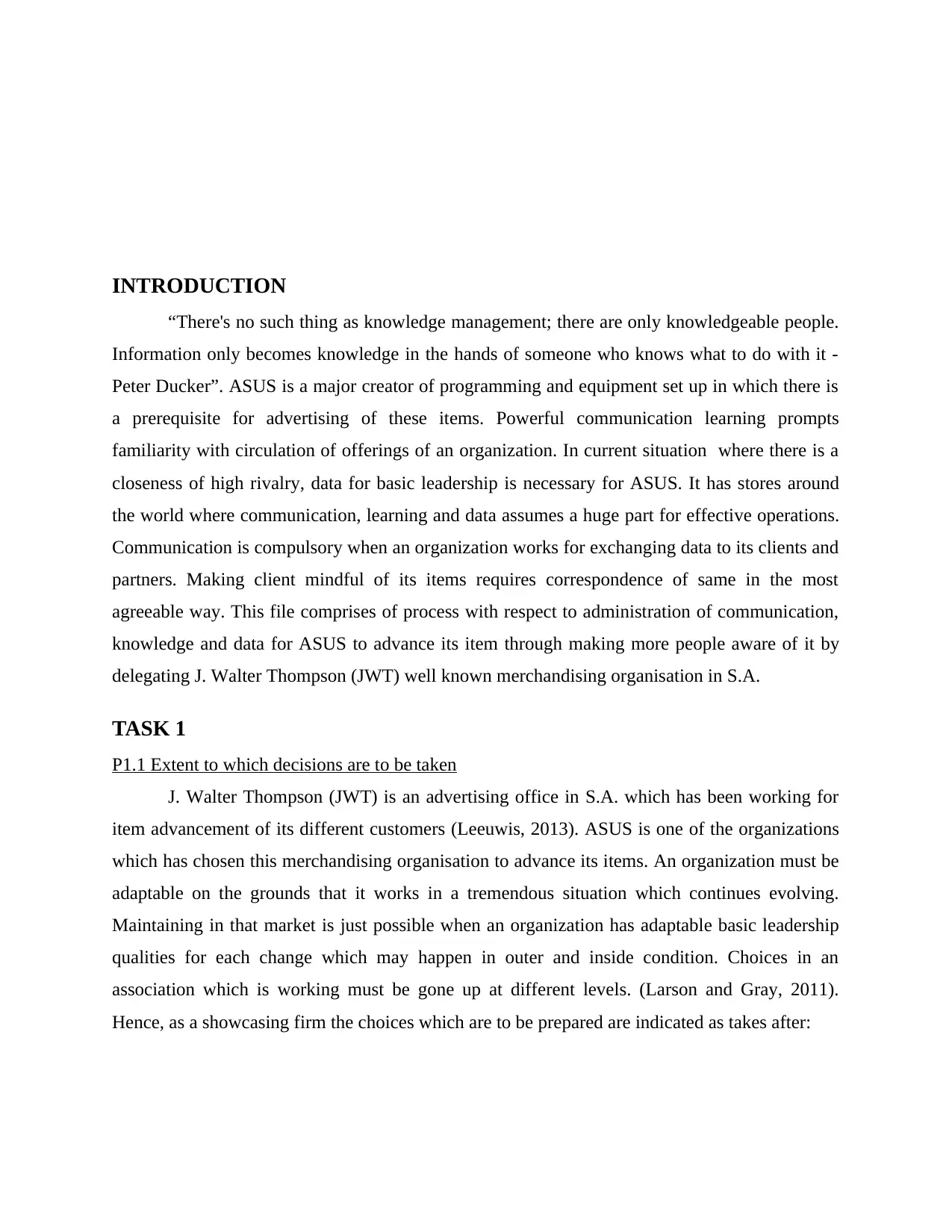
INTRODUCTION
“There's no such thing as knowledge management; there are only knowledgeable people.
Information only becomes knowledge in the hands of someone who knows what to do with it -
Peter Ducker”. ASUS is a major creator of programming and equipment set up in which there is
a prerequisite for advertising of these items. Powerful communication learning prompts
familiarity with circulation of offerings of an organization. In current situation where there is a
closeness of high rivalry, data for basic leadership is necessary for ASUS. It has stores around
the world where communication, learning and data assumes a huge part for effective operations.
Communication is compulsory when an organization works for exchanging data to its clients and
partners. Making client mindful of its items requires correspondence of same in the most
agreeable way. This file comprises of process with respect to administration of communication,
knowledge and data for ASUS to advance its item through making more people aware of it by
delegating J. Walter Thompson (JWT) well known merchandising organisation in S.A.
TASK 1
P1.1 Extent to which decisions are to be taken
J. Walter Thompson (JWT) is an advertising office in S.A. which has been working for
item advancement of its different customers (Leeuwis, 2013). ASUS is one of the organizations
which has chosen this merchandising organisation to advance its items. An organization must be
adaptable on the grounds that it works in a tremendous situation which continues evolving.
Maintaining in that market is just possible when an organization has adaptable basic leadership
qualities for each change which may happen in outer and inside condition. Choices in an
association which is working must be gone up at different levels. (Larson and Gray, 2011).
Hence, as a showcasing firm the choices which are to be prepared are indicated as takes after:
“There's no such thing as knowledge management; there are only knowledgeable people.
Information only becomes knowledge in the hands of someone who knows what to do with it -
Peter Ducker”. ASUS is a major creator of programming and equipment set up in which there is
a prerequisite for advertising of these items. Powerful communication learning prompts
familiarity with circulation of offerings of an organization. In current situation where there is a
closeness of high rivalry, data for basic leadership is necessary for ASUS. It has stores around
the world where communication, learning and data assumes a huge part for effective operations.
Communication is compulsory when an organization works for exchanging data to its clients and
partners. Making client mindful of its items requires correspondence of same in the most
agreeable way. This file comprises of process with respect to administration of communication,
knowledge and data for ASUS to advance its item through making more people aware of it by
delegating J. Walter Thompson (JWT) well known merchandising organisation in S.A.
TASK 1
P1.1 Extent to which decisions are to be taken
J. Walter Thompson (JWT) is an advertising office in S.A. which has been working for
item advancement of its different customers (Leeuwis, 2013). ASUS is one of the organizations
which has chosen this merchandising organisation to advance its items. An organization must be
adaptable on the grounds that it works in a tremendous situation which continues evolving.
Maintaining in that market is just possible when an organization has adaptable basic leadership
qualities for each change which may happen in outer and inside condition. Choices in an
association which is working must be gone up at different levels. (Larson and Gray, 2011).
Hence, as a showcasing firm the choices which are to be prepared are indicated as takes after:
⊘ This is a preview!⊘
Do you want full access?
Subscribe today to unlock all pages.

Trusted by 1+ million students worldwide
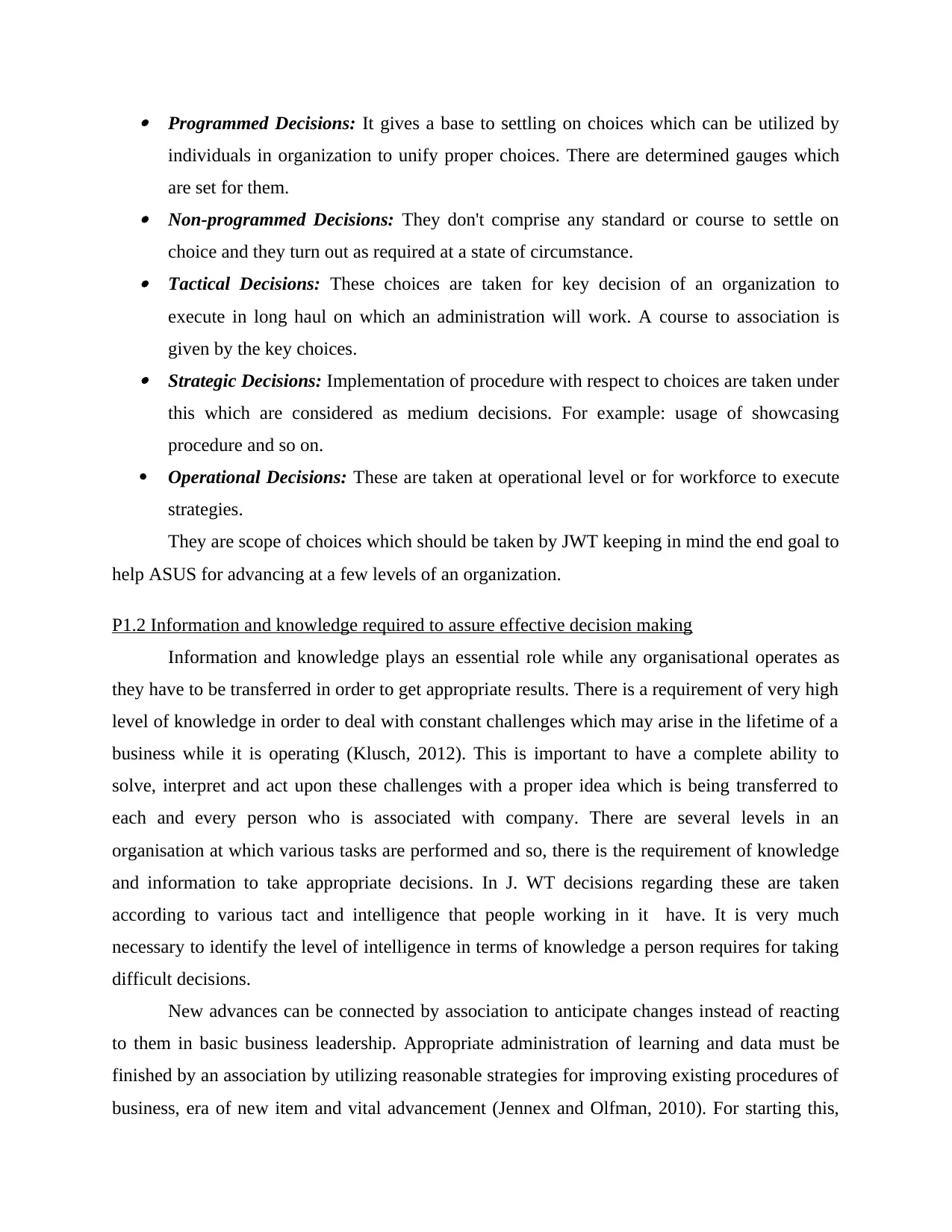
Programmed Decisions: It gives a base to settling on choices which can be utilized by
individuals in organization to unify proper choices. There are determined gauges which
are set for them. Non-programmed Decisions: They don't comprise any standard or course to settle on
choice and they turn out as required at a state of circumstance. Tactical Decisions: These choices are taken for key decision of an organization to
execute in long haul on which an administration will work. A course to association is
given by the key choices. Strategic Decisions: Implementation of procedure with respect to choices are taken under
this which are considered as medium decisions. For example: usage of showcasing
procedure and so on.
Operational Decisions: These are taken at operational level or for workforce to execute
strategies.
They are scope of choices which should be taken by JWT keeping in mind the end goal to
help ASUS for advancing at a few levels of an organization.
P1.2 Information and knowledge required to assure effective decision making
Information and knowledge plays an essential role while any organisational operates as
they have to be transferred in order to get appropriate results. There is a requirement of very high
level of knowledge in order to deal with constant challenges which may arise in the lifetime of a
business while it is operating (Klusch, 2012). This is important to have a complete ability to
solve, interpret and act upon these challenges with a proper idea which is being transferred to
each and every person who is associated with company. There are several levels in an
organisation at which various tasks are performed and so, there is the requirement of knowledge
and information to take appropriate decisions. In J. WT decisions regarding these are taken
according to various tact and intelligence that people working in it have. It is very much
necessary to identify the level of intelligence in terms of knowledge a person requires for taking
difficult decisions.
New advances can be connected by association to anticipate changes instead of reacting
to them in basic business leadership. Appropriate administration of learning and data must be
finished by an association by utilizing reasonable strategies for improving existing procedures of
business, era of new item and vital advancement (Jennex and Olfman, 2010). For starting this,
individuals in organization to unify proper choices. There are determined gauges which
are set for them. Non-programmed Decisions: They don't comprise any standard or course to settle on
choice and they turn out as required at a state of circumstance. Tactical Decisions: These choices are taken for key decision of an organization to
execute in long haul on which an administration will work. A course to association is
given by the key choices. Strategic Decisions: Implementation of procedure with respect to choices are taken under
this which are considered as medium decisions. For example: usage of showcasing
procedure and so on.
Operational Decisions: These are taken at operational level or for workforce to execute
strategies.
They are scope of choices which should be taken by JWT keeping in mind the end goal to
help ASUS for advancing at a few levels of an organization.
P1.2 Information and knowledge required to assure effective decision making
Information and knowledge plays an essential role while any organisational operates as
they have to be transferred in order to get appropriate results. There is a requirement of very high
level of knowledge in order to deal with constant challenges which may arise in the lifetime of a
business while it is operating (Klusch, 2012). This is important to have a complete ability to
solve, interpret and act upon these challenges with a proper idea which is being transferred to
each and every person who is associated with company. There are several levels in an
organisation at which various tasks are performed and so, there is the requirement of knowledge
and information to take appropriate decisions. In J. WT decisions regarding these are taken
according to various tact and intelligence that people working in it have. It is very much
necessary to identify the level of intelligence in terms of knowledge a person requires for taking
difficult decisions.
New advances can be connected by association to anticipate changes instead of reacting
to them in basic business leadership. Appropriate administration of learning and data must be
finished by an association by utilizing reasonable strategies for improving existing procedures of
business, era of new item and vital advancement (Jennex and Olfman, 2010). For starting this,
Paraphrase This Document
Need a fresh take? Get an instant paraphrase of this document with our AI Paraphraser
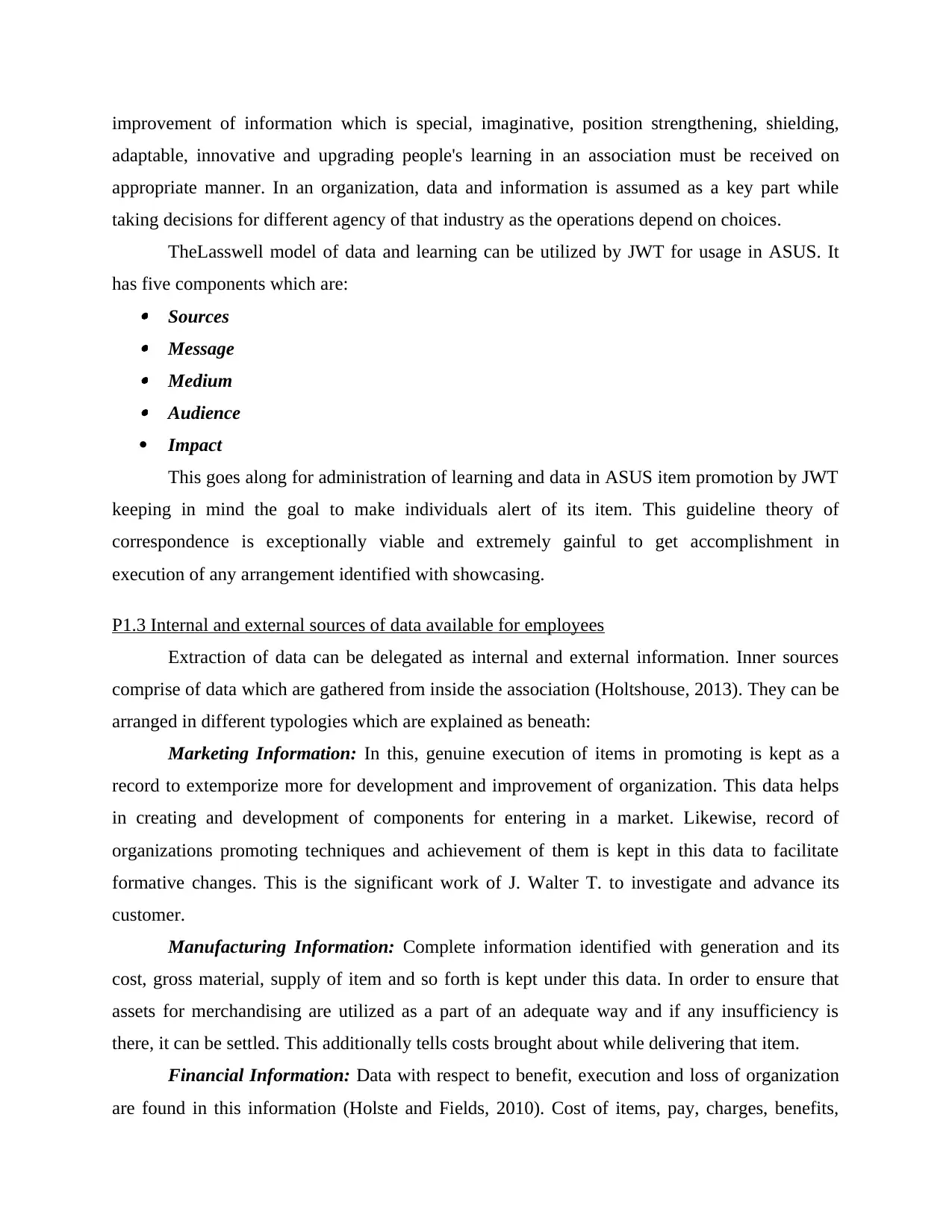
improvement of information which is special, imaginative, position strengthening, shielding,
adaptable, innovative and upgrading people's learning in an association must be received on
appropriate manner. In an organization, data and information is assumed as a key part while
taking decisions for different agency of that industry as the operations depend on choices.
TheLasswell model of data and learning can be utilized by JWT for usage in ASUS. It
has five components which are: Sources Message Medium Audience
Impact
This goes along for administration of learning and data in ASUS item promotion by JWT
keeping in mind the goal to make individuals alert of its item. This guideline theory of
correspondence is exceptionally viable and extremely gainful to get accomplishment in
execution of any arrangement identified with showcasing.
P1.3 Internal and external sources of data available for employees
Extraction of data can be delegated as internal and external information. Inner sources
comprise of data which are gathered from inside the association (Holtshouse, 2013). They can be
arranged in different typologies which are explained as beneath:
Marketing Information: In this, genuine execution of items in promoting is kept as a
record to extemporize more for development and improvement of organization. This data helps
in creating and development of components for entering in a market. Likewise, record of
organizations promoting techniques and achievement of them is kept in this data to facilitate
formative changes. This is the significant work of J. Walter T. to investigate and advance its
customer.
Manufacturing Information: Complete information identified with generation and its
cost, gross material, supply of item and so forth is kept under this data. In order to ensure that
assets for merchandising are utilized as a part of an adequate way and if any insufficiency is
there, it can be settled. This additionally tells costs brought about while delivering that item.
Financial Information: Data with respect to benefit, execution and loss of organization
are found in this information (Holste and Fields, 2010). Cost of items, pay, charges, benefits,
adaptable, innovative and upgrading people's learning in an association must be received on
appropriate manner. In an organization, data and information is assumed as a key part while
taking decisions for different agency of that industry as the operations depend on choices.
TheLasswell model of data and learning can be utilized by JWT for usage in ASUS. It
has five components which are: Sources Message Medium Audience
Impact
This goes along for administration of learning and data in ASUS item promotion by JWT
keeping in mind the goal to make individuals alert of its item. This guideline theory of
correspondence is exceptionally viable and extremely gainful to get accomplishment in
execution of any arrangement identified with showcasing.
P1.3 Internal and external sources of data available for employees
Extraction of data can be delegated as internal and external information. Inner sources
comprise of data which are gathered from inside the association (Holtshouse, 2013). They can be
arranged in different typologies which are explained as beneath:
Marketing Information: In this, genuine execution of items in promoting is kept as a
record to extemporize more for development and improvement of organization. This data helps
in creating and development of components for entering in a market. Likewise, record of
organizations promoting techniques and achievement of them is kept in this data to facilitate
formative changes. This is the significant work of J. Walter T. to investigate and advance its
customer.
Manufacturing Information: Complete information identified with generation and its
cost, gross material, supply of item and so forth is kept under this data. In order to ensure that
assets for merchandising are utilized as a part of an adequate way and if any insufficiency is
there, it can be settled. This additionally tells costs brought about while delivering that item.
Financial Information: Data with respect to benefit, execution and loss of organization
are found in this information (Holste and Fields, 2010). Cost of items, pay, charges, benefits,
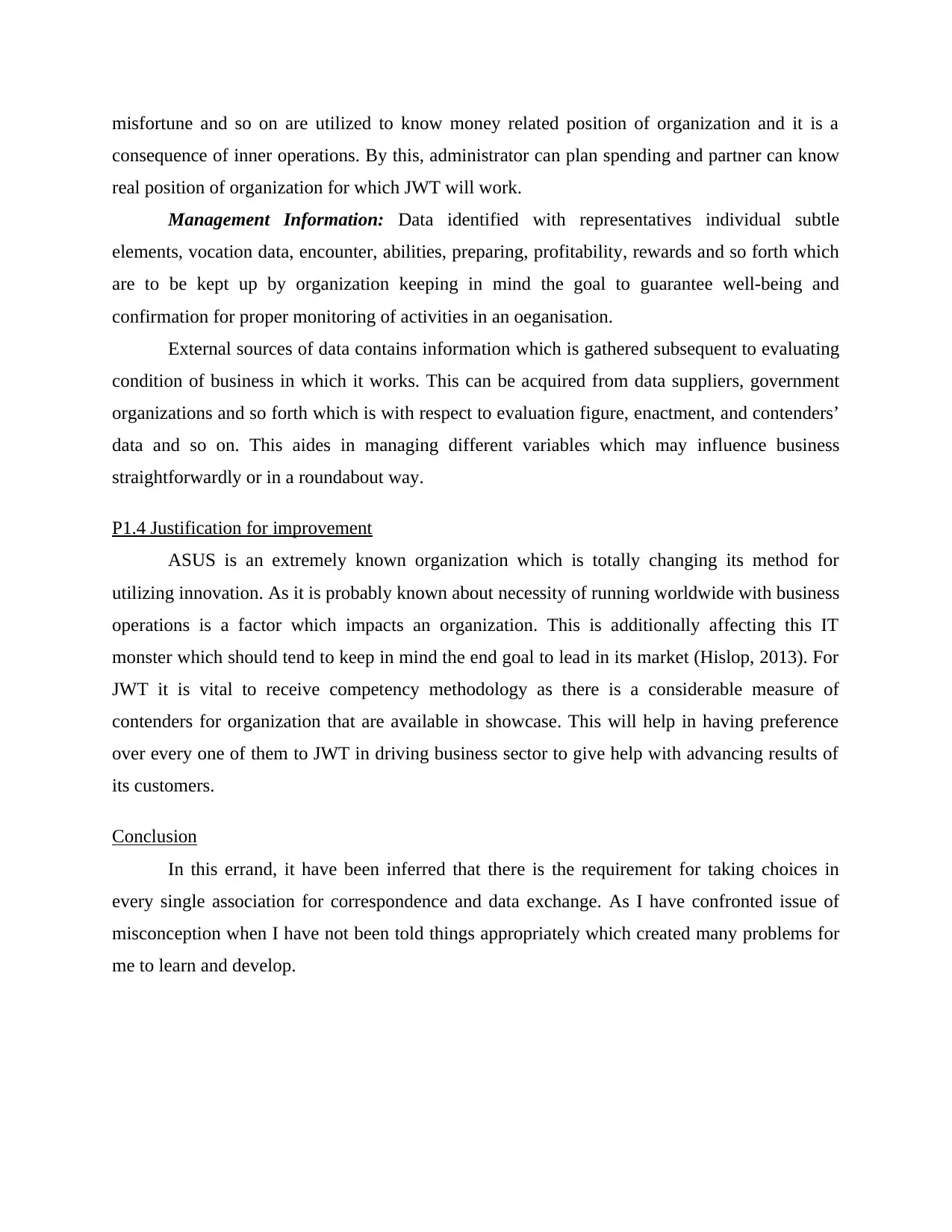
misfortune and so on are utilized to know money related position of organization and it is a
consequence of inner operations. By this, administrator can plan spending and partner can know
real position of organization for which JWT will work.
Management Information: Data identified with representatives individual subtle
elements, vocation data, encounter, abilities, preparing, profitability, rewards and so forth which
are to be kept up by organization keeping in mind the goal to guarantee well-being and
confirmation for proper monitoring of activities in an oeganisation.
External sources of data contains information which is gathered subsequent to evaluating
condition of business in which it works. This can be acquired from data suppliers, government
organizations and so forth which is with respect to evaluation figure, enactment, and contenders’
data and so on. This aides in managing different variables which may influence business
straightforwardly or in a roundabout way.
P1.4 Justification for improvement
ASUS is an extremely known organization which is totally changing its method for
utilizing innovation. As it is probably known about necessity of running worldwide with business
operations is a factor which impacts an organization. This is additionally affecting this IT
monster which should tend to keep in mind the end goal to lead in its market (Hislop, 2013). For
JWT it is vital to receive competency methodology as there is a considerable measure of
contenders for organization that are available in showcase. This will help in having preference
over every one of them to JWT in driving business sector to give help with advancing results of
its customers.
Conclusion
In this errand, it have been inferred that there is the requirement for taking choices in
every single association for correspondence and data exchange. As I have confronted issue of
misconception when I have not been told things appropriately which created many problems for
me to learn and develop.
consequence of inner operations. By this, administrator can plan spending and partner can know
real position of organization for which JWT will work.
Management Information: Data identified with representatives individual subtle
elements, vocation data, encounter, abilities, preparing, profitability, rewards and so forth which
are to be kept up by organization keeping in mind the goal to guarantee well-being and
confirmation for proper monitoring of activities in an oeganisation.
External sources of data contains information which is gathered subsequent to evaluating
condition of business in which it works. This can be acquired from data suppliers, government
organizations and so forth which is with respect to evaluation figure, enactment, and contenders’
data and so on. This aides in managing different variables which may influence business
straightforwardly or in a roundabout way.
P1.4 Justification for improvement
ASUS is an extremely known organization which is totally changing its method for
utilizing innovation. As it is probably known about necessity of running worldwide with business
operations is a factor which impacts an organization. This is additionally affecting this IT
monster which should tend to keep in mind the end goal to lead in its market (Hislop, 2013). For
JWT it is vital to receive competency methodology as there is a considerable measure of
contenders for organization that are available in showcase. This will help in having preference
over every one of them to JWT in driving business sector to give help with advancing results of
its customers.
Conclusion
In this errand, it have been inferred that there is the requirement for taking choices in
every single association for correspondence and data exchange. As I have confronted issue of
misconception when I have not been told things appropriately which created many problems for
me to learn and develop.
⊘ This is a preview!⊘
Do you want full access?
Subscribe today to unlock all pages.

Trusted by 1+ million students worldwide
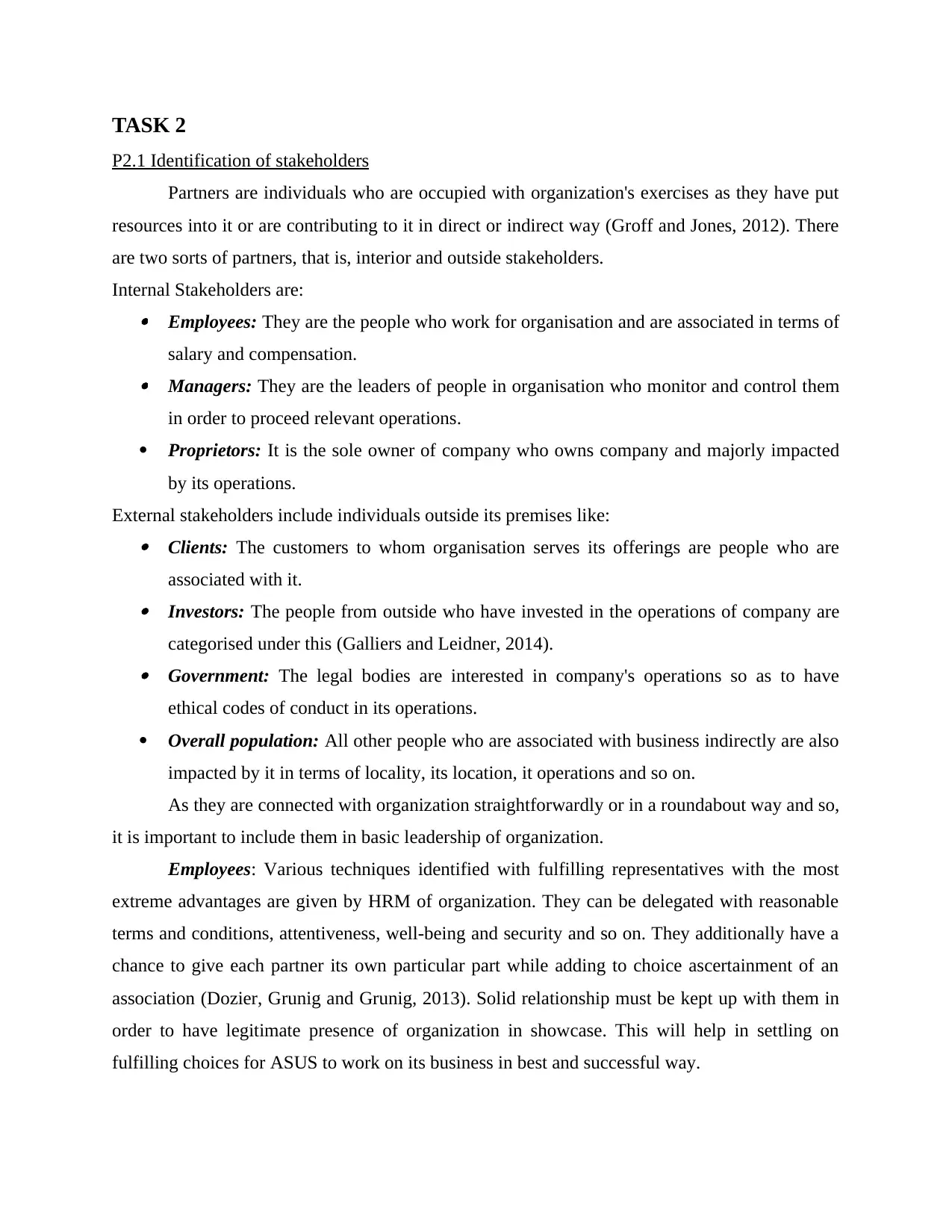
TASK 2
P2.1 Identification of stakeholders
Partners are individuals who are occupied with organization's exercises as they have put
resources into it or are contributing to it in direct or indirect way (Groff and Jones, 2012). There
are two sorts of partners, that is, interior and outside stakeholders.
Internal Stakeholders are: Employees: They are the people who work for organisation and are associated in terms of
salary and compensation. Managers: They are the leaders of people in organisation who monitor and control them
in order to proceed relevant operations.
Proprietors: It is the sole owner of company who owns company and majorly impacted
by its operations.
External stakeholders include individuals outside its premises like: Clients: The customers to whom organisation serves its offerings are people who are
associated with it. Investors: The people from outside who have invested in the operations of company are
categorised under this (Galliers and Leidner, 2014). Government: The legal bodies are interested in company's operations so as to have
ethical codes of conduct in its operations.
Overall population: All other people who are associated with business indirectly are also
impacted by it in terms of locality, its location, it operations and so on.
As they are connected with organization straightforwardly or in a roundabout way and so,
it is important to include them in basic leadership of organization.
Employees: Various techniques identified with fulfilling representatives with the most
extreme advantages are given by HRM of organization. They can be delegated with reasonable
terms and conditions, attentiveness, well-being and security and so on. They additionally have a
chance to give each partner its own particular part while adding to choice ascertainment of an
association (Dozier, Grunig and Grunig, 2013). Solid relationship must be kept up with them in
order to have legitimate presence of organization in showcase. This will help in settling on
fulfilling choices for ASUS to work on its business in best and successful way.
P2.1 Identification of stakeholders
Partners are individuals who are occupied with organization's exercises as they have put
resources into it or are contributing to it in direct or indirect way (Groff and Jones, 2012). There
are two sorts of partners, that is, interior and outside stakeholders.
Internal Stakeholders are: Employees: They are the people who work for organisation and are associated in terms of
salary and compensation. Managers: They are the leaders of people in organisation who monitor and control them
in order to proceed relevant operations.
Proprietors: It is the sole owner of company who owns company and majorly impacted
by its operations.
External stakeholders include individuals outside its premises like: Clients: The customers to whom organisation serves its offerings are people who are
associated with it. Investors: The people from outside who have invested in the operations of company are
categorised under this (Galliers and Leidner, 2014). Government: The legal bodies are interested in company's operations so as to have
ethical codes of conduct in its operations.
Overall population: All other people who are associated with business indirectly are also
impacted by it in terms of locality, its location, it operations and so on.
As they are connected with organization straightforwardly or in a roundabout way and so,
it is important to include them in basic leadership of organization.
Employees: Various techniques identified with fulfilling representatives with the most
extreme advantages are given by HRM of organization. They can be delegated with reasonable
terms and conditions, attentiveness, well-being and security and so on. They additionally have a
chance to give each partner its own particular part while adding to choice ascertainment of an
association (Dozier, Grunig and Grunig, 2013). Solid relationship must be kept up with them in
order to have legitimate presence of organization in showcase. This will help in settling on
fulfilling choices for ASUS to work on its business in best and successful way.
Paraphrase This Document
Need a fresh take? Get an instant paraphrase of this document with our AI Paraphraser
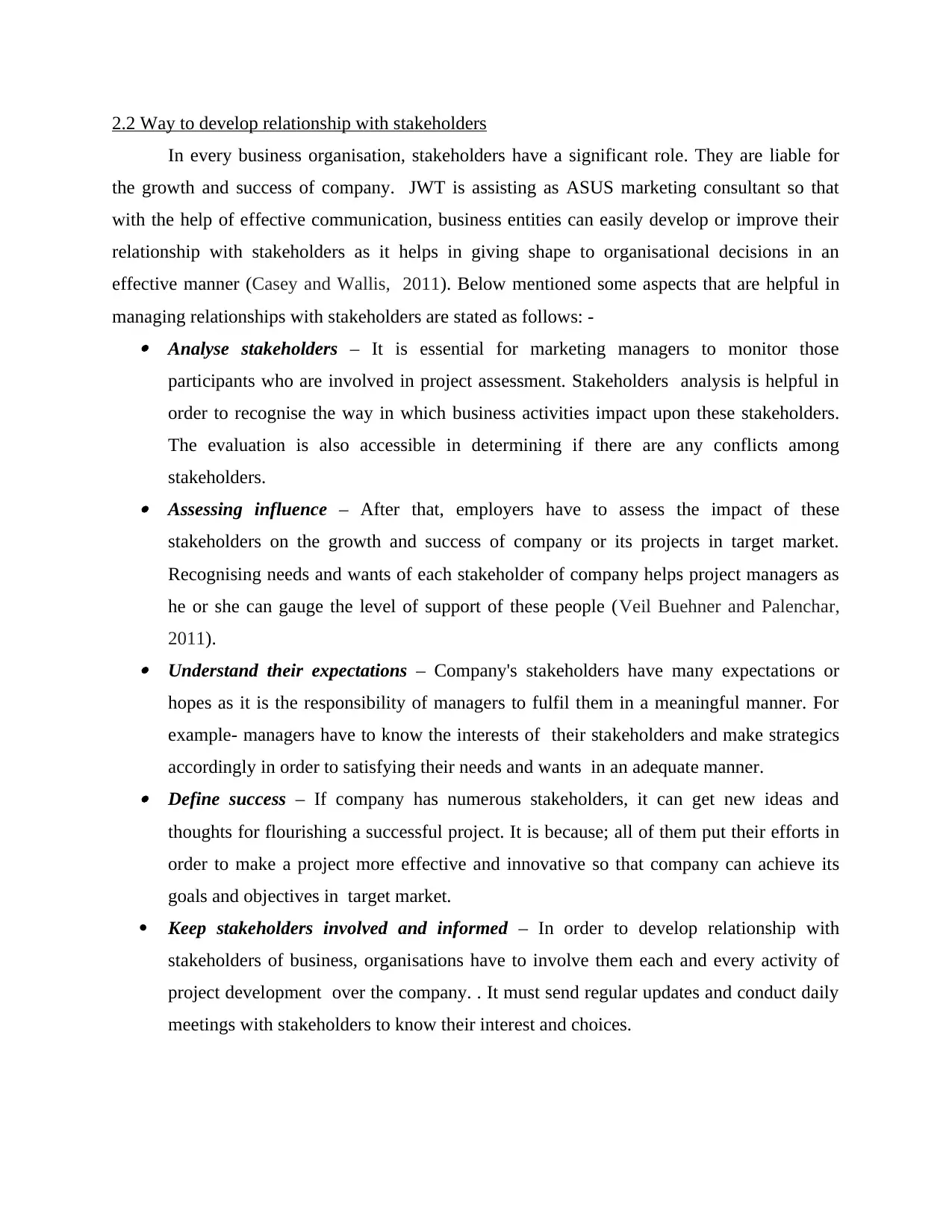
2.2 Way to develop relationship with stakeholders
In every business organisation, stakeholders have a significant role. They are liable for
the growth and success of company. JWT is assisting as ASUS marketing consultant so that
with the help of effective communication, business entities can easily develop or improve their
relationship with stakeholders as it helps in giving shape to organisational decisions in an
effective manner (Casey and Wallis, 2011). Below mentioned some aspects that are helpful in
managing relationships with stakeholders are stated as follows: - Analyse stakeholders – It is essential for marketing managers to monitor those
participants who are involved in project assessment. Stakeholders analysis is helpful in
order to recognise the way in which business activities impact upon these stakeholders.
The evaluation is also accessible in determining if there are any conflicts among
stakeholders. Assessing influence – After that, employers have to assess the impact of these
stakeholders on the growth and success of company or its projects in target market.
Recognising needs and wants of each stakeholder of company helps project managers as
he or she can gauge the level of support of these people (Veil Buehner and Palenchar,
2011). Understand their expectations – Company's stakeholders have many expectations or
hopes as it is the responsibility of managers to fulfil them in a meaningful manner. For
example- managers have to know the interests of their stakeholders and make strategics
accordingly in order to satisfying their needs and wants in an adequate manner. Define success – If company has numerous stakeholders, it can get new ideas and
thoughts for flourishing a successful project. It is because; all of them put their efforts in
order to make a project more effective and innovative so that company can achieve its
goals and objectives in target market.
Keep stakeholders involved and informed – In order to develop relationship with
stakeholders of business, organisations have to involve them each and every activity of
project development over the company. . It must send regular updates and conduct daily
meetings with stakeholders to know their interest and choices.
In every business organisation, stakeholders have a significant role. They are liable for
the growth and success of company. JWT is assisting as ASUS marketing consultant so that
with the help of effective communication, business entities can easily develop or improve their
relationship with stakeholders as it helps in giving shape to organisational decisions in an
effective manner (Casey and Wallis, 2011). Below mentioned some aspects that are helpful in
managing relationships with stakeholders are stated as follows: - Analyse stakeholders – It is essential for marketing managers to monitor those
participants who are involved in project assessment. Stakeholders analysis is helpful in
order to recognise the way in which business activities impact upon these stakeholders.
The evaluation is also accessible in determining if there are any conflicts among
stakeholders. Assessing influence – After that, employers have to assess the impact of these
stakeholders on the growth and success of company or its projects in target market.
Recognising needs and wants of each stakeholder of company helps project managers as
he or she can gauge the level of support of these people (Veil Buehner and Palenchar,
2011). Understand their expectations – Company's stakeholders have many expectations or
hopes as it is the responsibility of managers to fulfil them in a meaningful manner. For
example- managers have to know the interests of their stakeholders and make strategics
accordingly in order to satisfying their needs and wants in an adequate manner. Define success – If company has numerous stakeholders, it can get new ideas and
thoughts for flourishing a successful project. It is because; all of them put their efforts in
order to make a project more effective and innovative so that company can achieve its
goals and objectives in target market.
Keep stakeholders involved and informed – In order to develop relationship with
stakeholders of business, organisations have to involve them each and every activity of
project development over the company. . It must send regular updates and conduct daily
meetings with stakeholders to know their interest and choices.
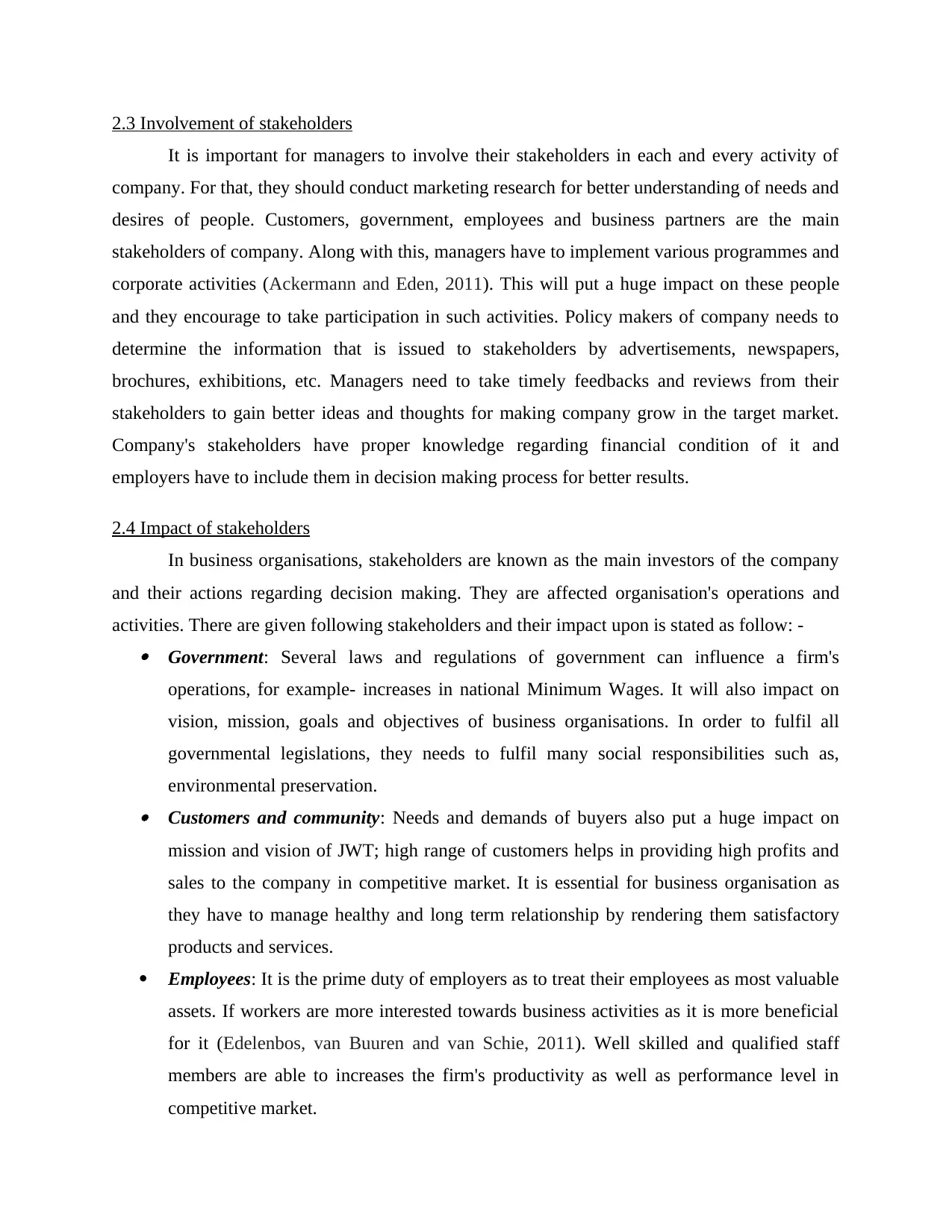
2.3 Involvement of stakeholders
It is important for managers to involve their stakeholders in each and every activity of
company. For that, they should conduct marketing research for better understanding of needs and
desires of people. Customers, government, employees and business partners are the main
stakeholders of company. Along with this, managers have to implement various programmes and
corporate activities (Ackermann and Eden, 2011). This will put a huge impact on these people
and they encourage to take participation in such activities. Policy makers of company needs to
determine the information that is issued to stakeholders by advertisements, newspapers,
brochures, exhibitions, etc. Managers need to take timely feedbacks and reviews from their
stakeholders to gain better ideas and thoughts for making company grow in the target market.
Company's stakeholders have proper knowledge regarding financial condition of it and
employers have to include them in decision making process for better results.
2.4 Impact of stakeholders
In business organisations, stakeholders are known as the main investors of the company
and their actions regarding decision making. They are affected organisation's operations and
activities. There are given following stakeholders and their impact upon is stated as follow: - Government: Several laws and regulations of government can influence a firm's
operations, for example- increases in national Minimum Wages. It will also impact on
vision, mission, goals and objectives of business organisations. In order to fulfil all
governmental legislations, they needs to fulfil many social responsibilities such as,
environmental preservation. Customers and community: Needs and demands of buyers also put a huge impact on
mission and vision of JWT; high range of customers helps in providing high profits and
sales to the company in competitive market. It is essential for business organisation as
they have to manage healthy and long term relationship by rendering them satisfactory
products and services.
Employees: It is the prime duty of employers as to treat their employees as most valuable
assets. If workers are more interested towards business activities as it is more beneficial
for it (Edelenbos, van Buuren and van Schie, 2011). Well skilled and qualified staff
members are able to increases the firm's productivity as well as performance level in
competitive market.
It is important for managers to involve their stakeholders in each and every activity of
company. For that, they should conduct marketing research for better understanding of needs and
desires of people. Customers, government, employees and business partners are the main
stakeholders of company. Along with this, managers have to implement various programmes and
corporate activities (Ackermann and Eden, 2011). This will put a huge impact on these people
and they encourage to take participation in such activities. Policy makers of company needs to
determine the information that is issued to stakeholders by advertisements, newspapers,
brochures, exhibitions, etc. Managers need to take timely feedbacks and reviews from their
stakeholders to gain better ideas and thoughts for making company grow in the target market.
Company's stakeholders have proper knowledge regarding financial condition of it and
employers have to include them in decision making process for better results.
2.4 Impact of stakeholders
In business organisations, stakeholders are known as the main investors of the company
and their actions regarding decision making. They are affected organisation's operations and
activities. There are given following stakeholders and their impact upon is stated as follow: - Government: Several laws and regulations of government can influence a firm's
operations, for example- increases in national Minimum Wages. It will also impact on
vision, mission, goals and objectives of business organisations. In order to fulfil all
governmental legislations, they needs to fulfil many social responsibilities such as,
environmental preservation. Customers and community: Needs and demands of buyers also put a huge impact on
mission and vision of JWT; high range of customers helps in providing high profits and
sales to the company in competitive market. It is essential for business organisation as
they have to manage healthy and long term relationship by rendering them satisfactory
products and services.
Employees: It is the prime duty of employers as to treat their employees as most valuable
assets. If workers are more interested towards business activities as it is more beneficial
for it (Edelenbos, van Buuren and van Schie, 2011). Well skilled and qualified staff
members are able to increases the firm's productivity as well as performance level in
competitive market.
⊘ This is a preview!⊘
Do you want full access?
Subscribe today to unlock all pages.

Trusted by 1+ million students worldwide
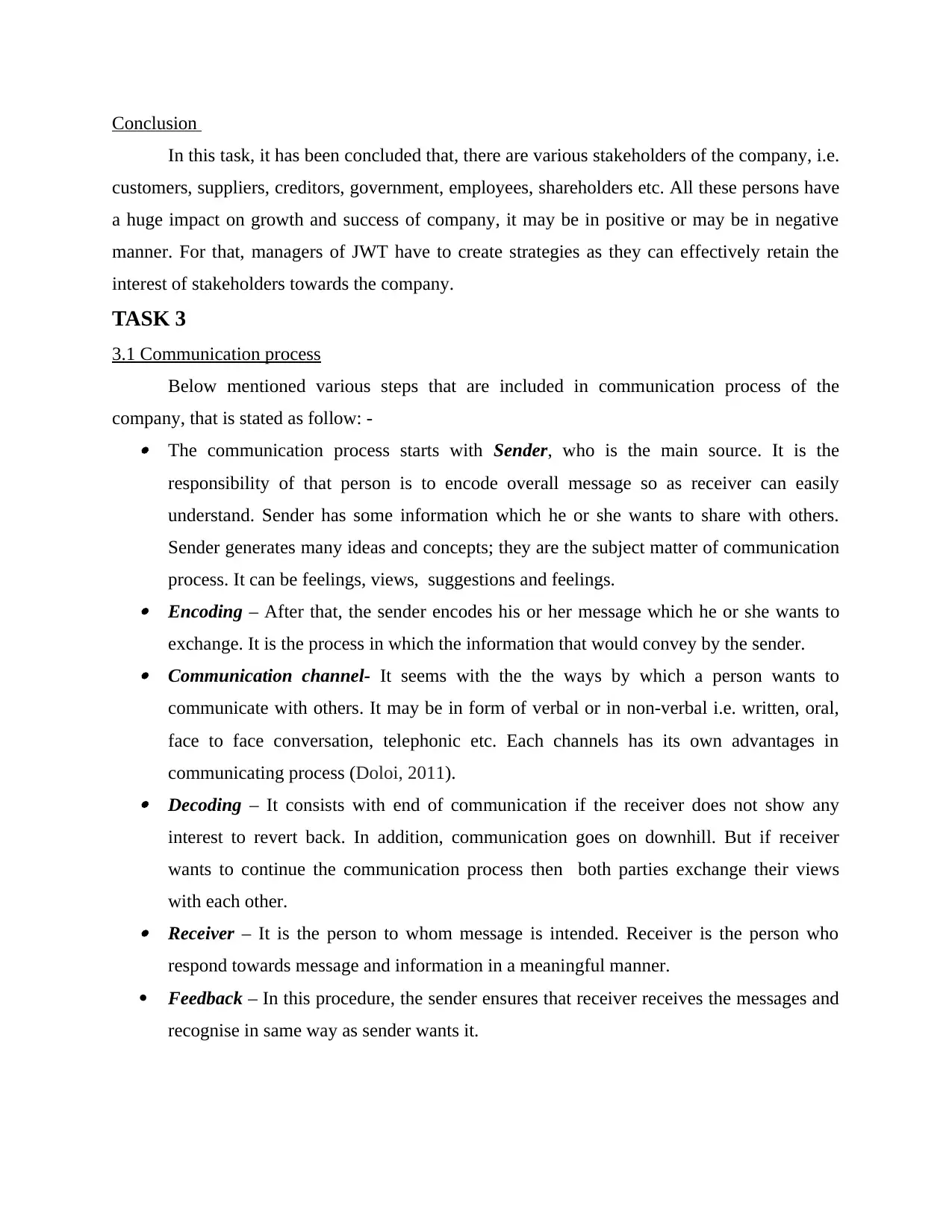
Conclusion
In this task, it has been concluded that, there are various stakeholders of the company, i.e.
customers, suppliers, creditors, government, employees, shareholders etc. All these persons have
a huge impact on growth and success of company, it may be in positive or may be in negative
manner. For that, managers of JWT have to create strategies as they can effectively retain the
interest of stakeholders towards the company.
TASK 3
3.1 Communication process
Below mentioned various steps that are included in communication process of the
company, that is stated as follow: - The communication process starts with Sender, who is the main source. It is the
responsibility of that person is to encode overall message so as receiver can easily
understand. Sender has some information which he or she wants to share with others.
Sender generates many ideas and concepts; they are the subject matter of communication
process. It can be feelings, views, suggestions and feelings. Encoding – After that, the sender encodes his or her message which he or she wants to
exchange. It is the process in which the information that would convey by the sender. Communication channel- It seems with the the ways by which a person wants to
communicate with others. It may be in form of verbal or in non-verbal i.e. written, oral,
face to face conversation, telephonic etc. Each channels has its own advantages in
communicating process (Doloi, 2011). Decoding – It consists with end of communication if the receiver does not show any
interest to revert back. In addition, communication goes on downhill. But if receiver
wants to continue the communication process then both parties exchange their views
with each other. Receiver – It is the person to whom message is intended. Receiver is the person who
respond towards message and information in a meaningful manner.
Feedback – In this procedure, the sender ensures that receiver receives the messages and
recognise in same way as sender wants it.
In this task, it has been concluded that, there are various stakeholders of the company, i.e.
customers, suppliers, creditors, government, employees, shareholders etc. All these persons have
a huge impact on growth and success of company, it may be in positive or may be in negative
manner. For that, managers of JWT have to create strategies as they can effectively retain the
interest of stakeholders towards the company.
TASK 3
3.1 Communication process
Below mentioned various steps that are included in communication process of the
company, that is stated as follow: - The communication process starts with Sender, who is the main source. It is the
responsibility of that person is to encode overall message so as receiver can easily
understand. Sender has some information which he or she wants to share with others.
Sender generates many ideas and concepts; they are the subject matter of communication
process. It can be feelings, views, suggestions and feelings. Encoding – After that, the sender encodes his or her message which he or she wants to
exchange. It is the process in which the information that would convey by the sender. Communication channel- It seems with the the ways by which a person wants to
communicate with others. It may be in form of verbal or in non-verbal i.e. written, oral,
face to face conversation, telephonic etc. Each channels has its own advantages in
communicating process (Doloi, 2011). Decoding – It consists with end of communication if the receiver does not show any
interest to revert back. In addition, communication goes on downhill. But if receiver
wants to continue the communication process then both parties exchange their views
with each other. Receiver – It is the person to whom message is intended. Receiver is the person who
respond towards message and information in a meaningful manner.
Feedback – In this procedure, the sender ensures that receiver receives the messages and
recognise in same way as sender wants it.
Paraphrase This Document
Need a fresh take? Get an instant paraphrase of this document with our AI Paraphraser
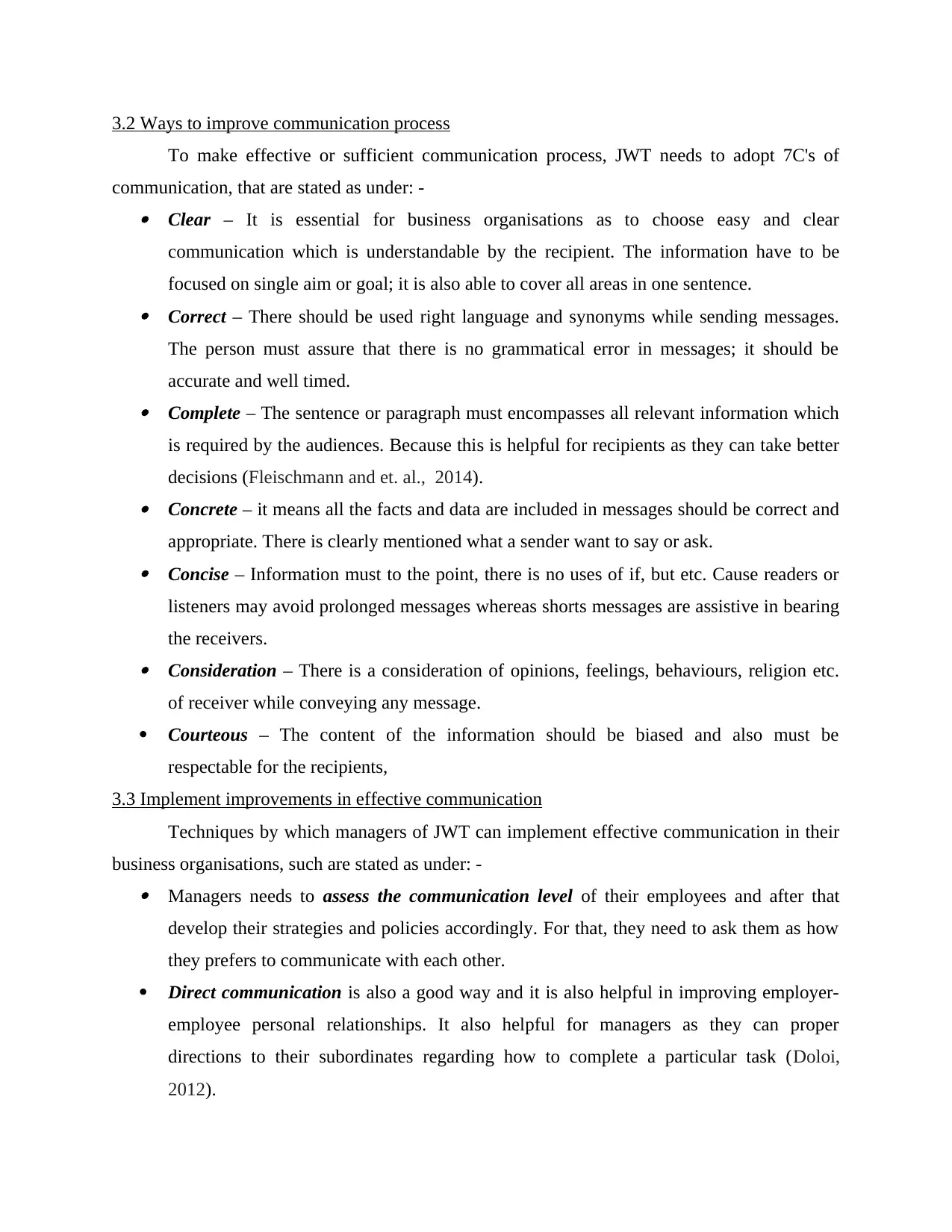
3.2 Ways to improve communication process
To make effective or sufficient communication process, JWT needs to adopt 7C's of
communication, that are stated as under: - Clear – It is essential for business organisations as to choose easy and clear
communication which is understandable by the recipient. The information have to be
focused on single aim or goal; it is also able to cover all areas in one sentence. Correct – There should be used right language and synonyms while sending messages.
The person must assure that there is no grammatical error in messages; it should be
accurate and well timed. Complete – The sentence or paragraph must encompasses all relevant information which
is required by the audiences. Because this is helpful for recipients as they can take better
decisions (Fleischmann and et. al., 2014). Concrete – it means all the facts and data are included in messages should be correct and
appropriate. There is clearly mentioned what a sender want to say or ask. Concise – Information must to the point, there is no uses of if, but etc. Cause readers or
listeners may avoid prolonged messages whereas shorts messages are assistive in bearing
the receivers. Consideration – There is a consideration of opinions, feelings, behaviours, religion etc.
of receiver while conveying any message.
Courteous – The content of the information should be biased and also must be
respectable for the recipients,
3.3 Implement improvements in effective communication
Techniques by which managers of JWT can implement effective communication in their
business organisations, such are stated as under: - Managers needs to assess the communication level of their employees and after that
develop their strategies and policies accordingly. For that, they need to ask them as how
they prefers to communicate with each other.
Direct communication is also a good way and it is also helpful in improving employer-
employee personal relationships. It also helpful for managers as they can proper
directions to their subordinates regarding how to complete a particular task (Doloi,
2012).
To make effective or sufficient communication process, JWT needs to adopt 7C's of
communication, that are stated as under: - Clear – It is essential for business organisations as to choose easy and clear
communication which is understandable by the recipient. The information have to be
focused on single aim or goal; it is also able to cover all areas in one sentence. Correct – There should be used right language and synonyms while sending messages.
The person must assure that there is no grammatical error in messages; it should be
accurate and well timed. Complete – The sentence or paragraph must encompasses all relevant information which
is required by the audiences. Because this is helpful for recipients as they can take better
decisions (Fleischmann and et. al., 2014). Concrete – it means all the facts and data are included in messages should be correct and
appropriate. There is clearly mentioned what a sender want to say or ask. Concise – Information must to the point, there is no uses of if, but etc. Cause readers or
listeners may avoid prolonged messages whereas shorts messages are assistive in bearing
the receivers. Consideration – There is a consideration of opinions, feelings, behaviours, religion etc.
of receiver while conveying any message.
Courteous – The content of the information should be biased and also must be
respectable for the recipients,
3.3 Implement improvements in effective communication
Techniques by which managers of JWT can implement effective communication in their
business organisations, such are stated as under: - Managers needs to assess the communication level of their employees and after that
develop their strategies and policies accordingly. For that, they need to ask them as how
they prefers to communicate with each other.
Direct communication is also a good way and it is also helpful in improving employer-
employee personal relationships. It also helpful for managers as they can proper
directions to their subordinates regarding how to complete a particular task (Doloi,
2012).
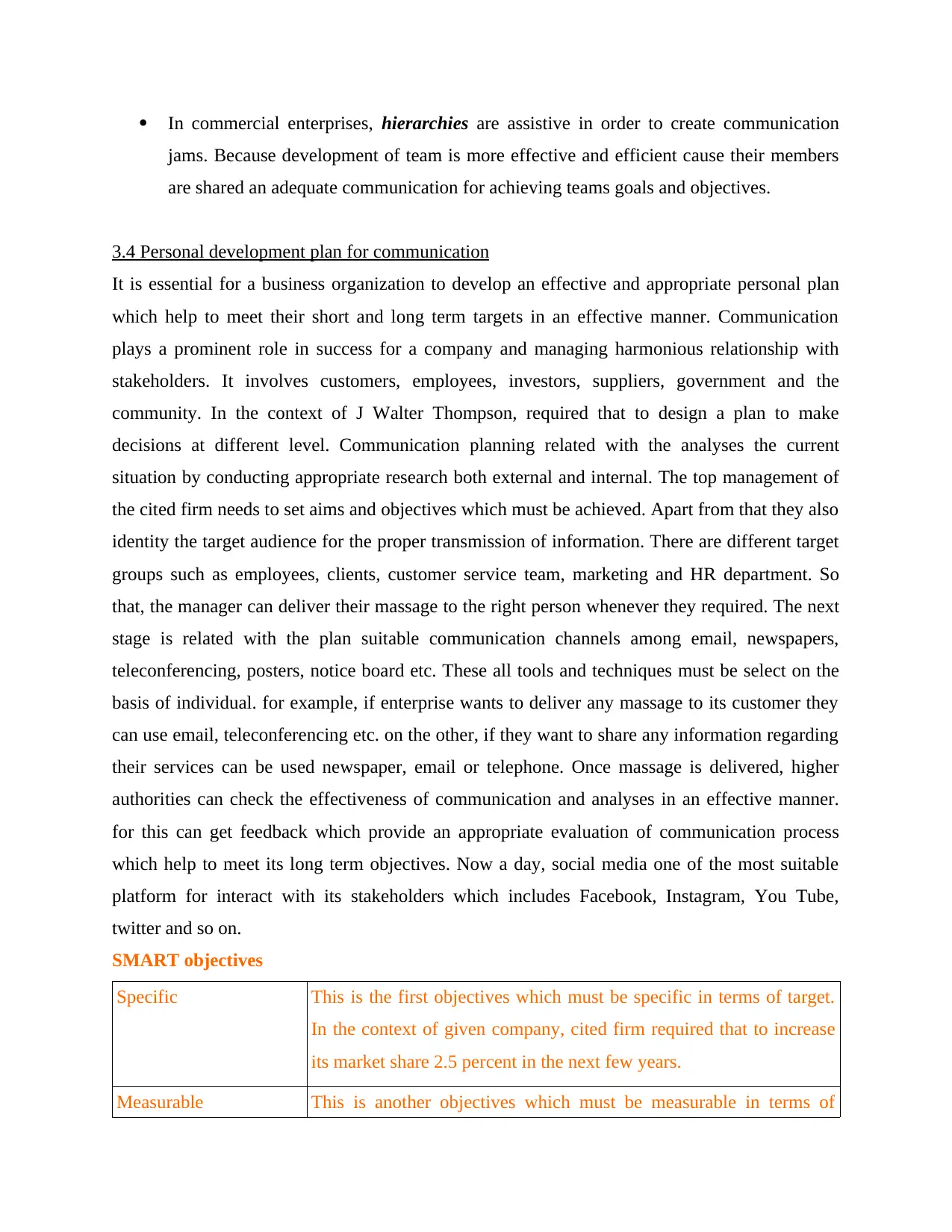
In commercial enterprises, hierarchies are assistive in order to create communication
jams. Because development of team is more effective and efficient cause their members
are shared an adequate communication for achieving teams goals and objectives.
3.4 Personal development plan for communication
It is essential for a business organization to develop an effective and appropriate personal plan
which help to meet their short and long term targets in an effective manner. Communication
plays a prominent role in success for a company and managing harmonious relationship with
stakeholders. It involves customers, employees, investors, suppliers, government and the
community. In the context of J Walter Thompson, required that to design a plan to make
decisions at different level. Communication planning related with the analyses the current
situation by conducting appropriate research both external and internal. The top management of
the cited firm needs to set aims and objectives which must be achieved. Apart from that they also
identity the target audience for the proper transmission of information. There are different target
groups such as employees, clients, customer service team, marketing and HR department. So
that, the manager can deliver their massage to the right person whenever they required. The next
stage is related with the plan suitable communication channels among email, newspapers,
teleconferencing, posters, notice board etc. These all tools and techniques must be select on the
basis of individual. for example, if enterprise wants to deliver any massage to its customer they
can use email, teleconferencing etc. on the other, if they want to share any information regarding
their services can be used newspaper, email or telephone. Once massage is delivered, higher
authorities can check the effectiveness of communication and analyses in an effective manner.
for this can get feedback which provide an appropriate evaluation of communication process
which help to meet its long term objectives. Now a day, social media one of the most suitable
platform for interact with its stakeholders which includes Facebook, Instagram, You Tube,
twitter and so on.
SMART objectives
Specific This is the first objectives which must be specific in terms of target.
In the context of given company, cited firm required that to increase
its market share 2.5 percent in the next few years.
Measurable This is another objectives which must be measurable in terms of
jams. Because development of team is more effective and efficient cause their members
are shared an adequate communication for achieving teams goals and objectives.
3.4 Personal development plan for communication
It is essential for a business organization to develop an effective and appropriate personal plan
which help to meet their short and long term targets in an effective manner. Communication
plays a prominent role in success for a company and managing harmonious relationship with
stakeholders. It involves customers, employees, investors, suppliers, government and the
community. In the context of J Walter Thompson, required that to design a plan to make
decisions at different level. Communication planning related with the analyses the current
situation by conducting appropriate research both external and internal. The top management of
the cited firm needs to set aims and objectives which must be achieved. Apart from that they also
identity the target audience for the proper transmission of information. There are different target
groups such as employees, clients, customer service team, marketing and HR department. So
that, the manager can deliver their massage to the right person whenever they required. The next
stage is related with the plan suitable communication channels among email, newspapers,
teleconferencing, posters, notice board etc. These all tools and techniques must be select on the
basis of individual. for example, if enterprise wants to deliver any massage to its customer they
can use email, teleconferencing etc. on the other, if they want to share any information regarding
their services can be used newspaper, email or telephone. Once massage is delivered, higher
authorities can check the effectiveness of communication and analyses in an effective manner.
for this can get feedback which provide an appropriate evaluation of communication process
which help to meet its long term objectives. Now a day, social media one of the most suitable
platform for interact with its stakeholders which includes Facebook, Instagram, You Tube,
twitter and so on.
SMART objectives
Specific This is the first objectives which must be specific in terms of target.
In the context of given company, cited firm required that to increase
its market share 2.5 percent in the next few years.
Measurable This is another objectives which must be measurable in terms of
⊘ This is a preview!⊘
Do you want full access?
Subscribe today to unlock all pages.

Trusted by 1+ million students worldwide
1 out of 19
Related Documents
Your All-in-One AI-Powered Toolkit for Academic Success.
+13062052269
info@desklib.com
Available 24*7 on WhatsApp / Email
![[object Object]](/_next/static/media/star-bottom.7253800d.svg)
Unlock your academic potential
Copyright © 2020–2025 A2Z Services. All Rights Reserved. Developed and managed by ZUCOL.




